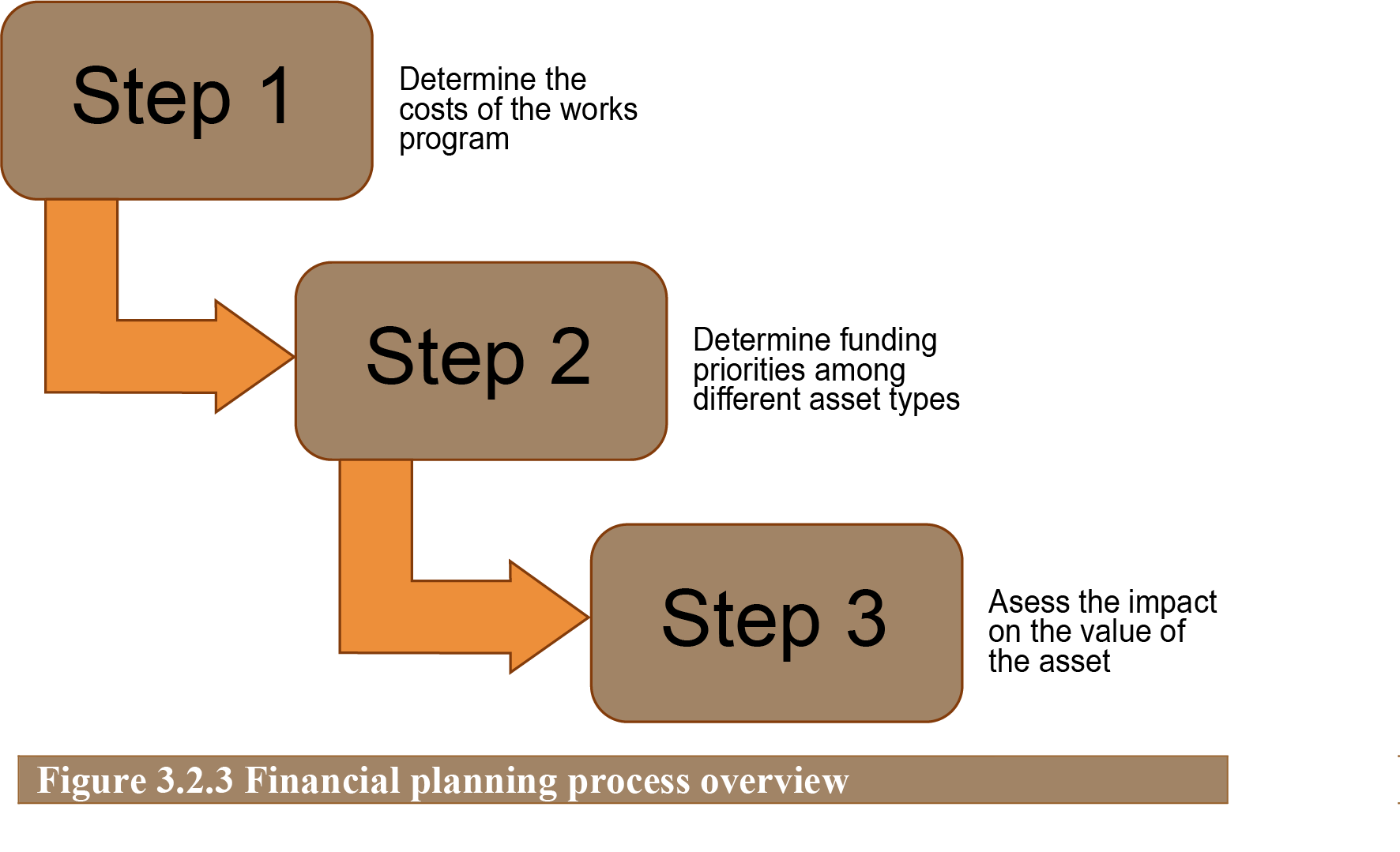
Asset Management Manual
A guide for practitioners!

Asset Management Manual
A guide for practitioners!
The process of building a financial plan is illustrated in Figure 3.2.3.

Step 1. Determining the cost of proposed works
The financial plan should build on the works plans (AMEC 2013) that contain the maintenance schemes the organization is required to undertake. Works plans are described in greater detail in section 3.4. The works plan should contain the schemes that have been prioritized according to the policy of the organization at least for the upcoming year but ideally for the next three to five years. It may also contain a number of different work plans to be implemented depending on the funding provided (Lepert 2012). Ideally, each asset group, such as pavements, structures, or lighting, should have determined costs of its own work plan.
Step 2. Allocating the funds among program areas
Depending on the funding available, there may be a requirement to allocate budgets to each asset type, such as pavements or structures, from a single capital allocation. Traditionally, many organizations have allocated budgets on a historical basis. For example, roads may get 60% of the maintenance budget and structures 20%. The financial plan, therefore, may be based on historical spending levels. More advanced organizations may consider prioritizing their assets to ensure that both those assets most in need of funding for the organization to meet its strategic priorities and those assets that may be critical towards the organization, such as strategic bridges, are funded. Such an approach to developing financial plans will ensure that the organization gets the greatest economic return. In doing so, however, the organization may have to accept that there may also be political requirements to address.
One approach to allocate funding among different assets may be based on ensuring that the optimum performance rather than the maximum performance is achieved for each asset. In organizations with a mature asset management program, this approach can be developed through a performance management framework that links assets to strategic and funding priorities.
For example, should a bridge fall down, even if the pavement on both sides is new the road will be totally closed to traffic. Conversely, should the pavement on both sides of a new bridge be in drastically bad condition, the traffic over the bridge will be greatly affected. This example illustrates a holistic consideration from each asset group to meet wider strategic objectives on the same route. In such an approach, consistency can be achieved by considering a common level of service for that route. An alternative approach may be to consider the risk associated with the poor performance of an asset group on that route. Generally, pavement management and bridge management are key asset concerns that need to be looked at holistically. Pavement deterioration is visible to road users and may be more politically sensitive for road organizations. Bridge deterioration is managed in terms of the risk and criticality of that structure to the local and national economy.
Step 2 becomes a challenge when budgets are constrained and there is insufficient funding to meet the required performance or eliminate the backlog of maintenance, which is the case most of the time.
Step 3. Assessing financial sustainability
It is important that the financial plan preserves the value of the assets in the organization’s ownership as much as possible. It is accepted that investment in roads contributes to the economy through well-maintained accessible roads. Depending on the organization and its accounting practices, the financial plan may also impact the balance sheet of the organization. For example, if the financial plan does not maintain the network in steady state condition, but because of known funding constraints the plan is unable to arrest deterioration, then the value of the assets will depreciate. This may result in additional financial charges to the organizations in order to fund this depreciation. Asset valuation is described in greater detail in Chapter 3.3 Asset Valuation. Developing a financial plan that is sustainable should be one objective of the organization.
In the U.S., the assessment of the financial sustainability of the transportation system currently uses the GASB 34 modified approach. GASB 34 requires state and local governments to report the value of their infrastructure assets in their annual financial report on an accrual accounting basis. Under this method, the loss in value of an asset is spread across the asset’s useful lifetime. In this way, the budget for maintenance intervention appears in parallel with the amount of loss in asset depreciation. More maintenance should, normally, induce less asset depreciation. In other words, an increase in asset maintenance could be balanced, to a certain extent, by a decrease of asset depreciation.
This approach does not take into account the benefits of maintaining the infrastructure asset on the total cost, including transportation costs for freight and people, environmental impacts, etc., which a cost-benefit analysis (CBA) approach can. GASB 34 also does not take into account the risks inherent in the planning process (e.g., unexpected reduction of budget, growth of traffic, severe climate events), which risk analysis does. More recently (2012), the MAP-21 legislation has required local authorities to provide the following information (Applied Pavement Technology 2013):
With this legislation, it is recognized that assessing financial sustainability requires preliminary lifecycle cost considerations and risk management.
The financial plan describes the amount of funding expected over the next 3 to 5 years and where it will come from (eventually, component by component). Such plan documents any assumptions made in preparing the plan. Therefore, it will help to evaluate the uncertainties and risks affecting the expected budget.